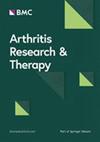Regulation of fibroblast-like synoviocyte function by cadherin 6 in rheumatoid arthritis
IF 4.6
2区 医学
Q1 Medicine
引用次数: 0
Abstract
Cadherins (CDH), such as CDH11, are glycoprotein adhesion molecules contributing to cell-cell interactions in health and disease. CDH11 has demonstrated important functions in rheumatoid arthritis (RA) fibroblast-like synoviocytes (FLS). In transcriptome expression studies, we observed that Cadherin 6 (CDH6) expression was higher in RA compared to osteoarthritis (OA). CDH6 is associated with cancer progression, but little information is known on the role of CDH6 in RA. The present study investigates CDH6 expression, regulation, function in FLS, and distribution in RA synovia. Synovial tissue and FLS were obtained from RA or OA patients undergoing joint replacement. CDH6 epigenetic marks and expression in RA and OA FLS were evaluated using public databases. CDH6 expression was determined by RT-PCR, Western blot, and immunostaining. RA and OA FLS were stimulated with cytokines and growth factors, and CDH6 mRNA expression was determined. CDH6 was silenced using siRNA, and the effect on migration, cell growth, apoptosis, autophagy, cell cycle, and signaling was studied. In our analysis of cadherin family expression, CDH6 expression was higher in RA than OA FLS. This was associated with differential chromatin accessibility and histone marks in the CDH6 promoter of RA FLS. H3K27ac was identified as an important regulator of CDH6 expression in RA FLS based on experiments using histone deacetylase inhibitors. TGFß, but not IL-1β, TNF, IL-17A, IFNγ, IL-6, or PDGF, increased CDH6 expression of cultured RA FLS. CDH6 knockdown significantly decreased RA FLS migration and cell growth. The latter was associated with increased apoptosis in CDH6 deficient FLS. Immunofluorescence showed CDH6 protein distribution in the membrane, perinuclear, and nuclear regions of cultured FLS. In RA synovial tissue, CDH6 expression was noted in FLS and macrophages within the lining and sublining regions. CDH6 expression is elevated in RA FLS due to epigenetic and local conditions of synovitis promoting migration, survival and cell growth, which are characteristic features of aggressive RA FLS. The intracellular distribution suggests additional functions beyond adhesion and homotypic aggregation, such as signaling and gene regulation. These data suggest CDH6 contributes to RA pathogenesis by influencing pathologic FLS behavior and could be a therapeutic target.类风湿性关节炎中钙粘蛋白6对成纤维细胞样滑膜细胞功能的调节
钙粘蛋白(CDH),如CDH11,是在健康和疾病中参与细胞-细胞相互作用的糖蛋白粘附分子。CDH11在类风湿关节炎(RA)成纤维细胞样滑膜细胞(FLS)中具有重要功能。在转录组表达研究中,我们观察到与骨关节炎(OA)相比,RA中的Cadherin 6 (CDH6)表达更高。CDH6与癌症进展有关,但关于CDH6在RA中的作用知之甚少。本研究探讨了CDH6在FLS中的表达、调控、功能以及在RA滑膜中的分布。滑膜组织和FLS取自接受关节置换术的RA或OA患者。利用公共数据库对RA和OA FLS中的CDH6表观遗传标记和表达进行评估。采用RT-PCR、Western blot和免疫染色检测CDH6的表达。细胞因子和生长因子刺激RA和OA FLS,检测CDH6 mRNA表达。利用siRNA沉默CDH6,研究其对迁移、细胞生长、凋亡、自噬、细胞周期和信号转导的影响。在我们的cadherin家族表达分析中,CDH6在RA中的表达高于OA FLS。这与RA FLS的CDH6启动子中的差异染色质可及性和组蛋白标记有关。通过组蛋白去乙酰化酶抑制剂的实验,H3K27ac被鉴定为RA FLS中CDH6表达的重要调节因子。TGFß升高了培养的RA FLS中CDH6的表达,而IL-1β、TNF、IL-17A、IFNγ、IL-6或PDGF的表达不升高。CDH6敲低显著降低RA FLS迁移和细胞生长。后者与CDH6缺陷FLS细胞凋亡增加有关。免疫荧光显示CDH6蛋白分布在培养的FLS的膜区、核周区和核区。在RA滑膜组织中,CDH6在FLS和巨噬细胞中表达。由于滑膜炎的表观遗传和局部条件促进迁移、存活和细胞生长,CDH6在RA FLS中表达升高,这是侵袭性RA FLS的特征。细胞内分布表明除了粘附和同型聚集外,还有其他功能,如信号传导和基因调控。这些数据表明CDH6通过影响病理性FLS行为参与RA的发病,可能是治疗靶点。
本文章由计算机程序翻译,如有差异,请以英文原文为准。
求助全文
约1分钟内获得全文
求助全文
来源期刊

Arthritis Research & Therapy
RHEUMATOLOGY-
CiteScore
8.60
自引率
2.00%
发文量
261
审稿时长
14 weeks
期刊介绍:
Established in 1999, Arthritis Research and Therapy is an international, open access, peer-reviewed journal, publishing original articles in the area of musculoskeletal research and therapy as well as, reviews, commentaries and reports. A major focus of the journal is on the immunologic processes leading to inflammation, damage and repair as they relate to autoimmune rheumatic and musculoskeletal conditions, and which inform the translation of this knowledge into advances in clinical care. Original basic, translational and clinical research is considered for publication along with results of early and late phase therapeutic trials, especially as they pertain to the underpinning science that informs clinical observations in interventional studies.
 求助内容:
求助内容: 应助结果提醒方式:
应助结果提醒方式:


